The shale boom: unlocking energy or harming the environment ?
The United States has witnessed a remarkable surge in oil and gas production in the early 2000s, fuelled by advancements in shale rock extraction. Once heavily reliant on imports, the U.S. is now the world's leading producer of both, thanks in large part to a technological innovation called fracking. However, this newfound energy abundance comes with a price. Historical trends, fracking techniques and environmental impacts, our energy expert and onboard scientist Beatrice Cordiano, tells us about the shale revolution.
The shale boom: unlocking energy or harming the environment?
Everyone knows renewables like solar and wind are likely the future of energy. But, for now, technology is making waves (for better or worse) in the way we pump energy up from underground rock formations known as shale. Such a process, called “fracking”, has led to a surge in U.S. oil and gas production, making it the world’s leading producer of both.
Let’s rewind to 1970.
Back then, the United States was an oil powerhouse, producing a record 9.6 million barrels of crude oil per day (BPD). However, the next 35 years saw a steady decline, as many of the early oil fields started running low on oil over time. In 2008, production had plummeted to 5 million BPD and imports skyrocketed to 9.7 million BPD. Nearly half of the oil the U.S. consumed that year came from abroad, mainly Saudi Arabia, Canada, Mexico, and Venezuela. The story for natural gas wasn’t much brighter, mirroring the oil trend. After peaking at 21.7 trillion cubic feet in 1973, production declined over the following decade and started recover timidly only in 1986.
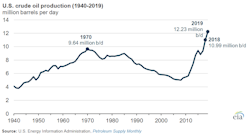
U.S. crude oil production (1940-2019) - million barrels per day
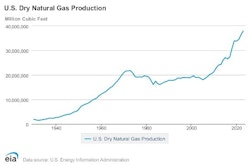
U.S. Dry Natural Gas Production - Million Cubic Feet
Many thought an energy crisis was imminent, but most were unaware that a revolution was brewing and that a technique was being explored by oil and gas companies and would soon shake up the energy markets.
The natural gas boom arrived first in 2005, followed by oil. Since then, the production has skyrocketed for both, marking the fastest oil and gas production increase in U.S history.
In less than two decades, shale oil and gas have gone from negligible to major players in the energy sector, accounting for 66% of crude oil and 79% of dry natural gas production in 2022. And today, with a crude oil production of 12.9 million barrels per day and natural gas dry production of 37.8 trillion cubic feet - almost twice as much as what they were ten and fifteen years ago respectively - United States is the world’s first producer of oil and gas, way ahead of Saudi Arabia and Russia.
The “shale revolution” brought indeed a radical change, shaking up the global energy landscape: it reshaped the geopolitics of oil and gas, challenging the dominance of traditional exporting nations, and reaffirming the North American power in an increasingly unstable world.
pour illustrer cela on a des photos de puits de pétrole et gaz qu'on avait fait en mer le long de la Californie en 2021 !

Offshore oil and gas rigs

Offshore oil and gas rigs
Fracking and horizontal drilling: the same treasure hunt
Let’s imagine oil and gas trapped deep underground, drilling is like using a giant straw to reach those pockets and suck them out. In the past, drillers would just dig a straight hole down (vertical drilling) but now, with traditional oil and gas reserves running low and limited space to drill, technological advancements are unlocking new unconventional resources. Horizontal drilling uses tools that can bend and turn underground: after reaching a certain depth – normally 5000 to 10000 feet, namely 1500 to 3000 meters - the drill takes a turn, going sideways for thousands of feet. This allows to reach oil and gas deposits far away from the drilling site, all from one surface location.
Fracking, short for hydraulic fracturing, is a different story. It's like having a treasure chest that's difficult to open. Drilling gets you there, but fracking helps you access what’s inside.
To extract oil and gas, drilling up to a good reservoir might not be enough. Good porosity and permeability are essential to recover hydrocarbons. Unconventional hydrocarbons are trapped as tiny bubbles within dense rock formations like shale, sandstone, and limestone and when these rocky layers are too tight or dense and the flow path is narrow or hindered, extraction becomes difficult and expensive. That’s where we need enhancement techniques and fracking is one of these. Once the well is secure and ready for production, a high-pressure mixture of water, chemicals, and sand is pumped down a wellbore to crack- open the rock layers which trap oil and gas, allowing them to flow out and be collected.
This was a niche technique until the mid-2000s, but it is nothing new: born as an experiment in 1947 and commercially used for the first time in 1949 in Kansas, it took off during the Obama administration and, since then, has been used to enhance production from conventional oil and gas wells.

It comes without doubts that it has been a blessing for the American economy, nevertheless, this blessing comes with its own downsides. Fracking can be like using a dynamite to open a piggy bank. Done right, it allows to access more oil and gas reserves in a more profitable way - a single well can exploit a geological layer over a much larger area – thus lowering energy prices. But if it is not done carefully, it turns out to be very risky.
A high price to pay
We cannot deny fracking leaves a big mark on the environment. Places like Pennsylvania and Texas, which were once covered in fields and forests, have seen landscapes drastically changed by drilling activity. Today they are industrial zones with roads and wells popping up everywhere and it is not a secret this large-scale transformation can have a ripple effect, harming plants and animals and disrupting entire ecosystems in ways we might not even fully understand.
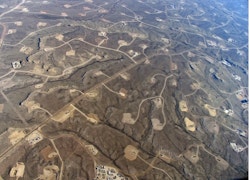
Fracking in Wyoming
Landscape is not the only impact, water is too. Shale fracking requires injecting massive quantities of water and chemicals underground. Therefore, energy companies do not only drill for oil and gas, but also for the enormous quantities of water needed to fracture shale rock. The water footprint of fracking a single well can reach up to 40 million gallons of water, or as much water we would need to take 950 000 baths. Since 2011, fracking has consumed nearly 1.5 trillion gallons of water nationwide, the equivalent to the tap water usage of the whole state of Texas.
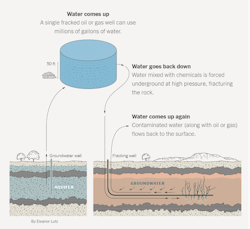
Fracking Illustration
Now, to avoid the costs for transporting water from far away, companies prioritize extraction from nearby resources, raising concerns about aquifers depletion and straining local treatment facilities. This extreme reliance on water can pose real threats to local resources, especially in areas where water is already scarce. On top of that, lax regulations exacerbate the problem. Oil companies can drill their own water wells without permits, and there's no consistent requirement that oblige them to report or monitor groundwater use for fracking. And so fracking runs unabated even when communities face water restrictions due to drought, creating a situation where essential needs compete with industrial demands.
The environmental consequences of fracking extend far beyond water usage. Fracking fluids can leak, contaminating groundwater and drinking water supplies, they can alter local geology and seem to trigger seismic activity in some regions. Additionally, fracking releases methane, a potent greenhouse gas with an even greater heat-trapping effect than carbon dioxide. According to some studies, it seems that around 4% of fracking's methane escapes, with some areas, like the Barnett Shale in Texas, experiencing annual leakages of up to 544 thousand tons of methane per year. That translates to 46 million tons of CO2, namely more than the annual emissions of Nevada or Connecticut. Not exactly an exciting news for the climate.
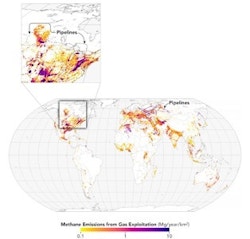
Emissions from Gas Exploitation in 2016
For how long this revolution will last, it is hard to say. Deposits are depleting and environmental issues cannot be ignored. And whether fracking is a good or bad thing for the environment, it is still debated: some see in shale oil and gas bridge fuels which can facilitate the phase out of coal, others fear that the shale revolution could just lock us into a cycle of fossil fuel reliance. Either point is true but what is sure is that for the moment, while we wait for renewables to extensively scale up, unconventional hydrocarbons remain indispensable to ensure the massive energy demand of United States and of a large part of the world.